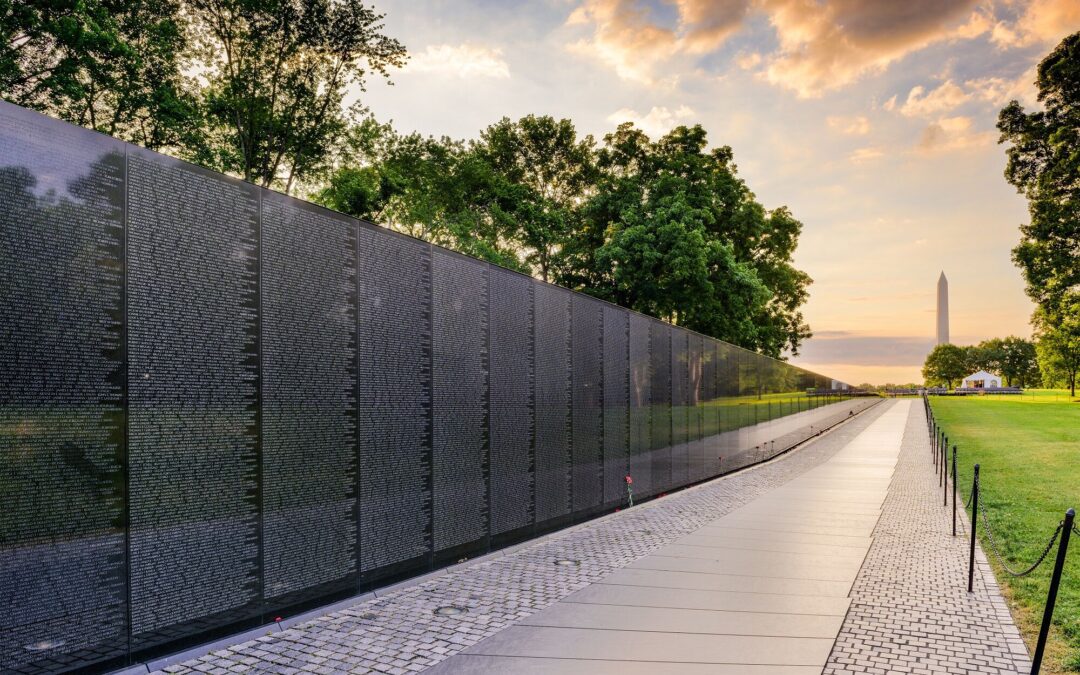In 1981, when the judges of the Vietnam Memorial competition opened the envelope on the back of the winning entry board, they found the name “Maya Lin” and the address of a Yale dormitory where the young woman lived as an undergraduate student. From among more than 1400 entries, many submitted by large, internationally recognized architectural firms, Maya Lin’s concept was chosen for its simplicity, elegance, and poignancy.
Rather than the typical white marble mausoleum, May Lin envisioned cutting a V-shape into the earth with polished stone. The more than 58,000 names of Americans who died during the conflict were to be inscribed on a highly reflective black granite chronologically so that each name was surrounded by those who served at the same time and the story of the war, from its beginnings in 1959 to its end in 1975, would be told through the men and women who lives were lost. In an almost mythological way, the visitor to the Memorial descends below the horizon line of the earth to find and touch the name of a loved one in a place of reflection and quiet repose and then they must rise back up into the life and activity of the world again. This subtle and profound concept however was not easily understood by members of the general public. The design was so different than the typical war memorial that very quickly a firestorm of controversy erupted as certain veteran groups and politicians rallied to change the design or if that was not possible, lobby Secretary of the Interior James Watt to kill the project outright.
Doing public art and architecture is challenging under the best of circumstances. Doing a work of architecture about the Vietnam War while the controversy was so fresh and the emotions so raw made the task that much more difficult. Managing those challenges as a young Chinese-American woman with no established firm or power base behind her seems, even in reflection, to be impossible. And yet, with the distance of time, we now know how this story would turn out: the young woman would fight valiantly for her design and see it through the many obstacles. The Vietnam Memorial would be built and become one of the favorite and most powerful works of art and architecture of its time. In 2008, the American Institute of Architects (AIA) awarded the Vietnam Veterans Memorial its “25-year Award” thereby recognizing the design as the single work of architecture to best represent excellence from the year of its creation upon a quarter-century of reflection.
Now many years later, Maya Lin is a well-known and successful designer but, she continues to blur the lines between Art, Architecture, and Landscape Design in her work. Several years ago, she was approached to undertake a renovation of Queen Ann Square, which was created by Doris Duke back in 1978. One complaint about Queen Ann Square is that is it artificially “preferences” Trinity Church by giving it the town green and visibility from afar that it never had during the time it was built. In a town where freedom and relative equality of different religions (even in Newport’s earliest days), this is a serious complaint about many. Other people appreciate the green, open space in the heart of an otherwise congested area. At a press conference to talk about the proposal, Maya Lin spoke about her appreciation of Newport, which is one of the reasons she agrees to take on the assignment. She talked up how she, through her study of Newport’s history, hopes to find material and inspiration to create something new and special that will serve Newport far into the future. Although we are all likely to learn more about this proposal as plans are implemented, sketches of the plan show the recreation of foundations of houses that were torn down to create the park will be restored as landscape features and sitting areas. In keeping the area open, but by revealing the architectural history of the site through landscape elements, perhaps Ms. Lin will again find a way to bring opposing sides together to create a remarkable solution as she did so long ago with the Vietnam Memorial.
Looking to renovate your space or create a new one? Let’s connect.
Join the Architectural Forum to stay up-to-date with architectural news from Rhode Island and abroad.
Ross Sinclair Cann, AIA, LEED AP, is a historian, educator, and practicing architect living and working in Newport. Maya Lin was a Teaching Assistant in an architectural history class that Mr. Cann took while studying at Yale. This article was initially published in ARCHI-TEXT, in Newport This Week, June 9, 2011.
